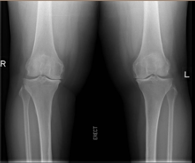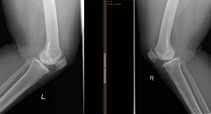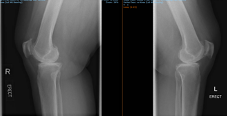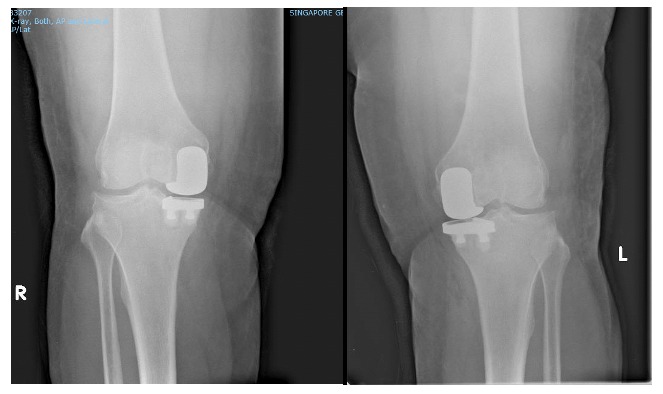Bilateral Unicompartmental/Partial Knee Replacement (UKA)
There are some patients that I will never forget despite the thousands I treat each year. It is either because of the severity of their orthopaedic conditions or how they turned out after their treatment. Every difficult case is a major learning experience for me, lessons learnt and cherished for my future patients. Sometimes you are all they have.
They have endured a difficult journey and have ended up in your clinic for help. We have been blessed with certain clinical and orthopaedic skills to help our patients. This is what surgeons do.
To replace or not to replace. This is the question that often comes to mind whenever I meet a patient who is between 50 to 60 years old with arthritic knee pain. Degeneration of the knee develops over many years and often only becomes painful in midlife. My patients in this age group are often still working, enjoying various forms of sports and hobbies or busy caring for their grandchildren. Many have endured many years of knee pain.
About Madam Zar*
Madam Zar is one such patient. She was about 50 years old when I first met her. She was always busy running her successful food stall with her husband and spent many hours each day on her feet.
She would experience excruciating pain in both her knees throughout the day and had difficulty walking and climbing stairs. She had trouble getting on the bus and had pain when she stood up from a sitting position.
Assessment and procedure
I noticed that Madam Zar had some bowing around her knees, something she had experienced over the last few years. This was a sign of arthritis.

Standing X-rays of both knees showing bony contact between the medical femoral condyle and medial tibial plateau. The joint space in the medial compartment of the knee is significantly reduced, a sure sign of arthritis.
Madam Zar explained that in the past, she had tried to lose weight, taken pain killers, gone for physiotherapy and applied ice to treat her knee pain. They had all eventually failed after a short period of pain relief.
I explained to Madam Zar that her X-rays showed degeneration or arthritis that was focused on the inner aspect of her knee. The thinning of the cartilage made her knees bowed and caused the debilitating symptoms she had. Cartilage in the outer (lateral) and front (patella-femoral) parts of her knee were largely preserved, and she didn’t have pain in those areas. Since it was the first-time meeting Madam Zar, I continued to prescribe her different pain killers and focused physiotherapy to ensure she had exhausted all her non-surgical options before discussing surgery.


Lateral (side view) X-rays of both knees with the patient standing as well as bending her knee showed preservation of her patello-femoral joints.
Several months passed and her symptoms were not significantly better. She was contemplating quitting her job and resting at home as the pain was unbearable. I explained that we had come to the point where surgery was needed to salvage her quality of life and prolong her career.

The skyline view of both kneecaps (patella) showed relatively well-preserved cartilage and patella-femoral joint space.
The next steps
As the cartilage on the medial compartment of her knee was eroded and both knees were bowed, I explained that a partial knee replacement for both knees will help her reduce her pain, increase her mobility and prolong her work life. A total knee replacement was not needed at this point as the other compartments of her knee was not painful, and there was radiological evidence that the cartilage there was largely preserved.
A partial knee replacement was also associated with quicker rehabilitation and more natural knee movements for patients. She understood that if other parts of her knee eventually degenerated in future, she still had the option to convert her partial knee replacement to a full knee replacement with good results. If she didn’t experience any pain in future, she didn’t have to do any further surgeries at all.
We proceeded to perform the partial knee replacement surgery to both her right and left knees. This was done as they were both equally symptomatic and debilitating.

X-rays of both knees showed the partial knee replacement implants. These implants have corrected her bow-leggedness and significantly reduced her knee pain.
Our team of physiotherapists and nurses ensured she was on her feet doing walking and stair-climbing exercises the day after surgery and for the rest of her 5-day hospital stay.
Post-procedure
Madam Zar was an extremely driven individual and was motivated to get better so that she can return to her food stall and help her husband. We iced her knee to help reduce the swelling and provided her with pain medication (anti-inflammatories) to reduce the pain and inflammation.

Lateral X-rays of her knee showing the implants supporting both the femur and tibia bones in the medical compartments. The worn-out cartilage and meniscus in this compartment have been removed.
At her follow up appointments, her wound healed well, and the physiotherapists reported that she was showing consistent improvements during her rehab sessions. With the appropriate rehab and anti-inflammatory medication, Madam Zar was back serving her best dishes at her food stall in about 2 months.
She got stronger by the day and received a lot of encouraging comments from regular customers who noticed her knees was not bowed any longer and she was walking faster after her surgery.
I have visited Madam Zar at her food stall and was happy to see her serving her customers with the support of her husband. While I enjoyed her food, I was extremely delighted that she could now continue working and doing what she enjoyed, serving up delicious dishes to her customers and manning her food stall with her husband.
While surgery is often the last resort, it is an ideal treatment option for those who are severely and continuously debilitated by pain and loss of function. Surgical techniques and implants have advanced over the years to significantly improve patients’ quality of life and their surgical experience.
As orthopaedic surgeons, we strive for our patients to return to their active lifestyles, continue to work to provide for their family and enjoy the company of their loved ones. We wish Madam Zar the very best in the next phase of her life.
*Names have been changed to protect the identity of individuals.